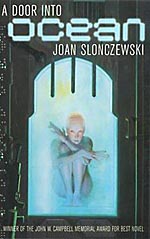
![]() Thomcat
Thomcat
12/21/2020
![]()
This John W. Campbell award winning fiction seemed slow to me, and great worldbuilding is not enough to compensate for the lack of a strong story.
The worldbuilding is told from a character's perspective, so we don't know a lot of space science or history. We know there is an ocean world and a stone world, and each is referred to as a "moon" of the other. The stone has a standard human society, the inhabitants of the ocean world have modifications - and very different speech, physiology, and outlook on life. We also know that these two worlds are part of a much larger domain (protectorate), with relativistic space travel. The conflict stems from stone world residents on the ocean world, and an inauspicious visit from the protector whose simple order launches a massive conflict.
This clash, while central to the theme, is shown mostly from one side - even though character perspectives on both sides are used. Worse, there are other factors that are left very unexplained - the recent destruction of a separate civilization, the occupation of one character's stone world village, and the nature of the visiting protector (a robot?). Worse yet are the individuals within the two people groups. Standard female advantages (growth, caring, learning) are nearly exclusively from the ocean world, despite the balanced population on the stone world.
As many other reviews have noted, good world building, but the story seems long - it took me more than a month to read. From descriptions of torture to continual threats of genocide, the latter part of this book feels ponderous. The author is a microbiologist, wrote the first half from an in-depth knowledge, and it shows. They are also a Quaker, and perhaps this is why only the failing of war is shown.
Their are three other books in the same universe. I'll probably not be adding them to my list - barring a positive conversation with a fan of this series.